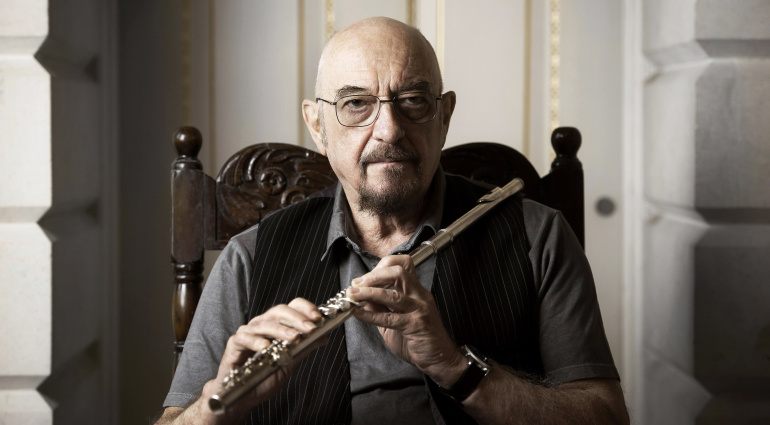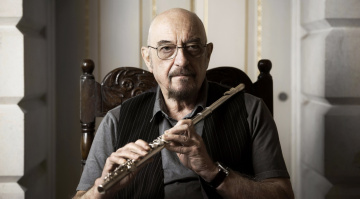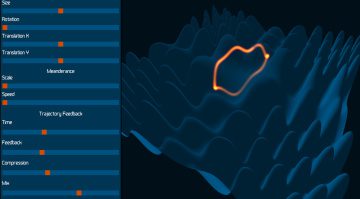Interview: Ian Anderson on Jethro Tull’s lastest album, Curious Ruminant
Gearnews offers Paul Rigg’s exclusive take on a generic interview with Ian Anderson and a review of Jethro Tull’s Curious Ruminant
In this Article
Interview: Ian Anderson
This interview was originally published on Passione Strumenti.
It’s hard to imagine the world of music without the iconic Jethro Tull frontman, Ian Anderson. Standing on one leg with a flute in hand, the extraordinarily talented and eccentric singer-songwriter was a key figure in the 1970s prog rock movement, selling over 60 million albums worldwide.
And today, nearly sixty years after Jethro Tull’s debut album, Ian Anderson is still innovating and releasing original music…
You have a unique style in playing but also in working in the studio: can you tell us about it?
Ian Anderson: I don’t really like the modern approach of keeping every take and putting them back together later. Some band members – or, really, everyone – prefer that method. They say, “Can we keep this and do another one?” But to me, if you want to do another one, it means the first one isn’t good enough. Why keep it? They like to piece together bits of different takes, but I find that process painfully boring.
I’m never afraid to hit the delete button, and once it’s gone, it’s gone forever. I use what’s called “destructive recording” in the digital domain, which means that when I re-record something to a track, the previous version is completely erased. There’s no going back, no saving multiple takes to sift through later.
For me, if something isn’t right – be it timing, intonation, diction, or a technical issue – I prefer to redo it until it’s right. I don’t want to clutter up my hard drive or my brain with unnecessary material. That’s how I’ve always worked, since the days of analog recording. On tape, once you recorded a track, the old take was gone forever. I’ve been working this way for 56 years and I don’t regret anything I’ve deleted, especially since I can’t remember what it was!
How long have you been working on Curious Ruminant?
Ian Anderson: Demos of some tracks were made in 2007. The long song Drink from the Same Well was born in 2007 as a demo for a live performance with Hariprasad Chaurasia, an Indian classical flautist. It was never recorded, released or played during our tour of India and Dubai, and was essentially forgotten until my son discovered it on an old computer.
He was deleting some old files and he said, “What is this?” and I said, “Oh, that sounds familiar,” because it had a working title. I kept the keyboards from that demo and recorded new flutes, bass, drums, cajon, electric, and acoustic guitars, and turned it into a big, epic Jethro Tull song. I think it’s the third longest piece I’ve done (after Thick as a Brick and Baker Street Muse).
However, most of the lyrics and most of the music were recorded between May and July 2024. The following month I worked on the artwork, booklets, and photographs, once the recordings and master mixing were finished.
Does the title Curious Ruminant mean that you spent a significant amount of time contemplating this album?
Ian Anderson: Yes, that’s right. One of my priest friends – now retired, canon of Wakefield Cathedral – contacted me when the title track was released as a video. The day it came out, he immediately emailed me, asking, “Curious Ruminant, what does that mean? Does it mean nosy cow?”
I said, “Not really.” He’s “curious” in the sense of being curious, not in the sense of being strange or bizarre, but of wanting to learn something. Once you’ve learned and registered something, the “ruminant” part comes into play. As a noun, “ruminant” often refers to a three-toed mammal that chews grass, regurgitates it, and enjoys a second helping. But it also refers to a contemplative person.
That’s what I try to do every day: learn something new. I like to go to bed at night thinking, “I have a little more knowledge than I had yesterday. I learned something today.” Then I go over it in my head and think about it. That way you start to put things into context in your life.
You’ve enriched your band of David Goodier, John O’Hara and Scott Hammond with the debut of guitarist Jack Clark, former keyboardist Andrew Giddings and drummer James Duncan: Why?
Ian Anderson: Andrew Giddings came in because we kept his keyboard part from the original demo. And James came in because he was available to work on the days Scott was busy.
Last summer I had set aside some time to record this album, but suddenly I had a deadline to release it early this year. The band members weren’t always available: they had summer vacations, other projects they were involved in, or teaching commitments when they weren’t working with me.
When working with a band, it becomes obvious how much each member’s musical skills and stylistic choices bring to a project. When they go beyond the basic notes of an arrangement, they add nuance, flavor, and subtlety to the recording. As a producer and mixer, I enjoy working with these idiosyncratic contributions of individuals. It’s exciting to build on them, and the result is something unique. I’ve always appreciated the contributions of band members over the past fifty-six years or so.
How do you approach writing a song?
Ian Anderson: For me the most important thing is to create a momentum and a drive. I often aim to have a vocal master done within an hour or an hour and a half. I don’t like to linger; it’s about capturing the moment.
It’s like the “decisive moment” in photography, as Cartier-Bresson put it. The same principle applies to songwriting and singing. Some of the best songs I’ve written have been completed and recorded on the same day.
That doesn’t mean it’s trivial: it’s about harnessing that creative momentum. Over the next few days, that energy becomes an unstoppable force, and riding that “bullet train” is incredibly exciting.

The songs seem to be a bit more personal than in the past…
Ian Anderson: From the beginning, I was aiming for something more personal. You’ll notice that there are a lot more instances of “I” and “me” in the lyrics. I’m usually more objective, but this album is different. It’s really about me, not in an Alanis Morissette “poor me” way, or in the “I woke up this morning” blues tradition, but I wanted to make the lyrics more intimate.
Can you give us an example?
Ian Anderson: Interim Sleep was originally written as something between prose and poetry, to provide imagined comfort to those who have suffered a loss. It’s written as if I were advising someone not to cry too much. I suggest that “I’m somewhere in the next room” or “outside the window, among the stars.” It’s a text that is meant to offer comfort, not in a morbid way, but as something uplifting and warming to the spirit.
Did you purposely give this album an “acoustic folk” flavor?
Ian Anderson: Yeah, it was intentional. I took out a mandolin, put new strings on it, and I also bought a little tenor guitar, a four-string guitar tuned like a mandolin. I kept those instruments on hand, and they became the starting point for writing three or four songs. It was a deliberate choice to approach those songs from a different direction.
Although some of the songs ended up with full band arrangements, with drums, bass and electric guitars, they all started with a main mandolin track and lead vocal. This initial structure was what I focused on, much like some of the songs on the 1971 Aqualung album, which I recorded in the studio when the other guys were on tea breaks or not on the schedule that day.
Will this album be taken on tour?
Ian Anderson: Unfortunately, the days of taking an album on tour and playing it in its entirety on stage are largely over. Modern concerts rely on synchronized video content, lighting effects, and technology that ties everything together, so last-minute changes throw the whole system out of whack. Even in 1969, after our second album, we were faced with the challenge of choosing what to leave out because there was more material than we could fit into a live concert. Over the years, this challenge has grown. It is now impossible to represent the full range of musical styles and eras in which we have worked, so we have to select examples that hint at the bigger picture.
Some songs, like Aqualung, Locomotive Breath, and Bourrée, are landmarks. They have remained in the setlist, not out of obligation, but because I am genuinely proud of them. Over the years, we have performed them in different arrangements, sometimes sticking closely to the originals, other times completely reimagining them. These songs hold a special place for me and remain staples of the live show.

Album Review: Curious Ruminant – Jethro Tull
Jethro Tull’s Curious Ruminant will be released on March 7, 2025, and will feature nine new tracks ranging from short, two-and-a-half-minute songs to the nearly 17-minute epic “Drink From The Same Well.” While not a concept album like 2002’s The Zealot Gene or 2023’s RökFlöte, Curious Ruminant revisits the band’s classic 1970s sound, a nostalgic blend of progressive rock and folk influences that will resonate with longtime fans.
The animated video for the title track, released a month before the album’s launch, has already racked up nearly half a million views on YouTube, a testament to Jethro Tull’s enduring appeal. It’s easy to see why: Curious Ruminant is both a catchy track and a repeat listen. The interplay between acoustic and electric instrumentation is beautifully arranged, and Ian Anderson’s voice is thoughtful and moving, addressing existential themes. He sings, for example: “Asking ‘Why am I here?’…answering ‘Why am I everywhere?’” This track, with its references to Freud and its reflections on mortality and loneliness, is undoubtedly a highlight of the album.
The opening track, “Puppet and the Puppet Master,” however, begins with a soaring piano motif that playfully hints at a new direction for the band. But when Anderson’s flute enters, the song settles into familiar Tull territory, fusing folk rock with prog. It’s a clever twist, one that shows the band’s ability to evolve while still staying true to their roots. The absence of Martin Barre is certainly felt, but the album more than makes up for it with some excellent guitar solos, especially on the opener.
The second single, “Tipu House,” picks up the pace, with Ian Anderson’s raspy flute evoking the spirit of classics like “Cross-eyed Mary” and “Pibroch (Cap in Hand).” The lyrics seem to subtly address the dark side of social success. As Ian Anderson stated in a press release, the song touches on the idea of “greatness” as a relative concept, alluding to the complexity of fame and power in the modern world.
“Savannah of Paddington Green” offers a softer moment, with acoustic guitar and accordion setting a reflective tone. Next comes “Stygian Hand,” a rougher track, featuring Ian Anderson’s passionate, masterfully enunciated voice, one of the album’s standout performances.
At nearly 17 minutes, the sprawling “Drink From The Same Well” is the album’s magnum opus, dominating the second half of Curious Ruminant much like the extended compositions of Genesis and Camel in the golden age of ’70s prog rock. Starting in a serene, contemplative mood, the track gradually picks up momentum, with Anderson’s flute becoming more energetic and the drums driving the pace. Anderson’s voice enters the scene around the eight-minute mark, delivering the haunting refrain “they drink from the same well as you.”
The unexpected closing track, “Interim Sleep,” is perhaps the most intimate song Ian Anderson has ever written. Clocking in at just over two minutes, it sheds the band’s signature sound for a darker, more reflective moment. With lines like “when interim sleep takes me, I want you close beside, no tears, no sad goodbye,” it offers a meditative reflection on mortality and the passage of time. The image of “the station where trains start and stop on the separate journeys of our many lives” evokes the Buddhist concept of reincarnation, making this a thought-provoking way to close the album.
In addition to Ian Anderson’s iconic flute solos and melodies, the album also features a variety of instruments, including accordion, mandolin, and acoustic and tenor guitars. These subtle additions to the mix create a folk-rock backdrop that harks back to Tull’s 1970s heyday, providing fans with a sound that’s both nostalgic and fresh.
For longtime followers, the familiar blend of acoustic folk and thought-provoking lyrics will surely be a welcome return. It’s worth noting that Ian Anderson’s voice remains as strong and distinct as ever.
Fans old and new will find much to appreciate in this latest chapter in the band’s illustrious career.
More Information
One response to “Interview: Ian Anderson on Jethro Tull’s lastest album, Curious Ruminant”

 5,0 / 5,0 |
5,0 / 5,0 | 







“voice remains as strong and distinct as ever” – You must be joking. His voice has been thin and weak for quite some time now and as a long time fan, listening to it these days is difficult when compared to the long gone quality it used to have. I am happy Ian/Tull is still releasing music, and if he wishes to keep singing, he should absolutely do so by all means. He probably dearly loves doing it, but let’s be realistic about how it sounds these days please. My own feeling is it is time to find someone else to do the singing, or perhaps to at least back him up or double track the vocals to create the full strength sound the music deserves.